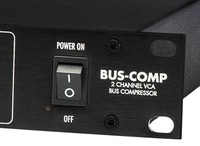
Review by George Shilling
The Trakker is a new mono compressor/limiter from Cranesong. Although similar in appearance to the STC-8 Stereo Compressor, the designer has taken a somewhat different approach. However, there are also some similarities, such as Class A electronics, solid construction from steel and aluminium, and bluey-green knobs. Although the workings are squeezed into a 1U height, it is a fairly deep box which feels decidedly weighty, no doubt due to the large torroidal transformer, and multitudinous heatsinks, including a huge external one protruding from the rear. These seem generously over specified, as the unit feels fairly cool for a Class A unit.
Designer David Hill has a boffin’s obsessive attention to detail in all areas, an example of which is four different voltage settings (set internally). Using the 230V setting instead of 240V in a 240V environment would probably not be disastrous, but perhaps the unit might run hotter. Input and Output XLRs are accompanied by a DB9 connector for attaching a fully balanced sidechain, and a DB15 for linking up to a further 7 Trakkers. In this mode, the Trakker claims to, erm, track within 0.1dB for accurate surround-sound program compression. In this mode, only the slaves’ Gain controls are active. These unusual connectors make things neat and tidy, but could be a nuisance in any situation other than a permanent installation, due to their non-standard nature.
On the front are slightly damped rotary controls for Threshold, Attack, Release, Knee and Output Gain, and a 16-position switch for mode selection. Legending could be better, but is a slight improvement over that on the STC-8: the mode switch is here accompanied by colour-coded LEDs. The variable knobs are mostly given scales of 1-10, which is sensible as settings interact and are dependent on program and mode. They seem to vary to always provide a perfect range of adjustment. These are a joy to use. Output Gain is simply that – no attenuation can be achieved with this knob, simply a make-up of up to 14dBs, which is perfect. The long LED meter is superb, relating accurately to what one hears when set to Gain Reduction mode. There is also an Output Level indication available. Toggle switches are provided for power, meter, link, and hard-wired bypass, in which mode compression is still metered, which can be handy or confusing depending on your point of view.
The sixteen-position switch offers four modes, with the same four variations of each mode. I don’t know why there are not two four-position switches, which would have made operation simpler and mode comparison easier. The four quadrants of the switch equate to modes Hard, Soft, Optical and Air Optical compressor characteristics. Hard refers to the knee, (the Knee knob is for fine tuning), and this mode effectively turns the unit into a peak limiter. Optical aims to emulate the sound of certain vintage units, and when the other knobs are set to recommended settings, this is a fairly convincing replication of a vintage Teletronix LA3 compressor. Air Optical mode adds a small high frequency boost to replicate compensatory treble-lift circuits found in certain vintage valve compressors.
The four sub-modes found within each main four sections are related to amplifier colouration: Clean, Vintage (tube or ‘old-style Class A’), Clean with VCA artefacts and Vintage with VCA artefacts. Vintage paths add colouration set to replicate that found when using triode tube circuits and single-ended Class A transistor circuits, which translates as second harmonic colouration, with third harmonic as clipping is approached. I compared a Urei LA3A and found that to replicate the ratio characteristics a higher knee setting than suggested was necessary. Air Optical mode was very similar-sounding. I also compared a Teletronix LA2A to Optical Vintage, and this again required a steeper knee setting than recommended to match those characteristics, but once dialled in, sounded convincing.
The differences between these modes can be fairly subtle, dependant on program and other settings, but it should be noted that all controls interact, and the Optical settings especially have an element of program-dependency. VCA artefacts are only apparent when the gain is changing; only on faster settings are the colourations apparent. Vintage VCA adds the most extreme colouration, with an apparent emphasis and added dynamism in the high-mid frequencies and an obvious presence boost in the region associated with guitar string finger noise or vocal detail. On drums, extremely fast settings sound terrific, especially with a steep knee. The differences between the modes are more obvious in these extreme circumstances. With slower settings, instruments are especially clean and detailed, and vocals really cook.
This unit is excellent in sound quality and operation. It is difficult to make it sound bad or distort in a nasty way. All deliberate colourations are subtle, and the overall impression is always of cleanliness and supreme signal integrity. Sometimes it is impossible to decide on the suitability of one particular subtly different setting over the other 15! But it would take a long time to really get to know this machine, and perhaps that is the beauty of it. I would love to spend some more time with it…
Reproduced with kind permission from www.georgeshilling.com. Copyright ©



